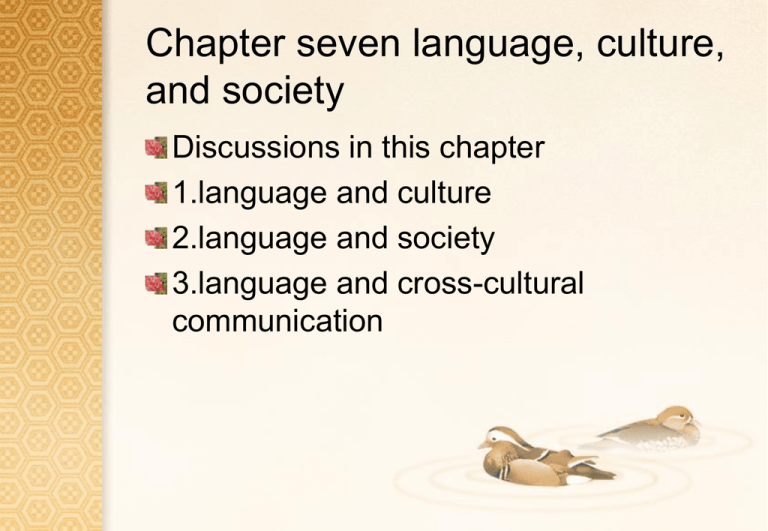
Chapter seven language, culture,
and society
Discussions in this chapter
1.language and culture
2.language and society
3.language and cross-cultural
communication
7.1.1how does language relate
to culture?
Language study conducted in the past
Ever since the beginning of the
eighteenth century, the linguistic inquiry
of language has been either
comparative and historical or structural
and formalized in nature.
Changes took place at the start of the
20th century----to study language
anthropologically .
Anthropological linguistics
A branch of linguistics which studies
the relationship between language and
culture in a community, e.g. its tradition,
beliefs, and family structure.
语言学的一个分支,研究一个社团的语
言和文化之间的关系,如传统、信仰和
家庭结构。
For example, anthropological linguists have
studied the ways in which relationship within
the family are expressed in different cultures
(kinship terminology), and they have studied
how people communicate with one another
at certain social and cultural events, e.g.
ceremonies, rituals, and meetings, and then
related this to the overall structure of the
particular community.
例如,人类语言学家对家庭成员关系在
不同文化中的表达方式进行了研究,对
于人们在某些社会文化活动,如庆典、
仪式及会议中的交际方式,他们也作了
研究,并将这些研究和特定社团的整体
结构联系起来。
Some areas of anthropological
linguistics are closely related to areas
of sociolinguistics and the ethnography
of communication.
人类语言学的某些领域与社会语言学和
交际人种学有着紧密的联系。
Pioneers in
Europe:(England) Malinowski, Firth.
North America: (America ) Boas, Sapir,
and Whorf.
Work in England
The meaning of a word greatly
depended upon its occurrence in a
given context, or rather, upon a real
language situation in life.
Wood: two interpretations
1.
2.canoe
Speech act theory
Language is a mode of action
This view of language is the basis for
the generation of the speech act theory.
Contribution by Malinowski
Paved the way for a cultural, rather, a
contextual study of language use in
Britain.
His influence
Under his anthropological view of
language and being fully aware of the
importance of the context in the study
of language use, Firth, a leading figure
in a linguistic tradition later known as
the London school, tried to set up a
model for illustrating the close
relationships between language use
and its co-occurrent factors. He
developed
The strong cultural-oriented implications
of the theory by Firth
1.the creativity and diversity of
linguistic idiosyncrasy in language use.
2.“who speaks (or writes )what
language (or what language variety) to
whom and when and to what end”
The furtherance of the theory by
Halliday
The founder of systemic-functional
linguistics,
He views language from a socially
semiotic or interactional perspective,
he interprets grammar functionally as a
resource of meaning potential, and his
linguistic model in the study of
literature.
Research work in America
Boas, Sapir, Whorf
The anthropological approach to the
study of language and culture laid a
firm foundation in the history of
linguistic development.
Ethnography of communication
The study of the place of language in
culture and society. Language is not
studied in isolation but within a social
and/ or cultural setting. Ethnography of
communication studies, for example,
how people in a particular group or
community communicate with each
other and how the social relationships
between these people affect the type of
language they use.
对语言在文化和社会中的位置的研究。
语言的研究不是孤立的而是在社会和/或
文化环境内进行的。交际人种学研究,
例如,特定群体或社团内的人们如何相
互交际的,这些人之间的社会关系是如
何影响他们所使用的语言的。
The concept of an ethnography of
communication was advanced by the
American social anthropologist and
linguist Hymes and this approach is
important in sociolinguistics and
applied linguistics.交际人种学是由美国
社会人类学家和语言学家海姆斯倡导的,
对于社会语言学和应用语言学来说是一
个重要部分。
Components of SPEAKING
S
P
E
A
K
I
N
G
A theory about the relation of
language and culture
It is influential and extremely
controversial
The hypothesis concerning the
language, thought, and culture.
Suggested by Benjiamin Lee Whorf
The Sapir—Whorf Hypothesis
Suggestions of the hypothesis
Language helps mould people’s way of
thinking;
Different languages may probably express
speakers’ unique ways of understanding the
world.
In other words, it means:
1.language may determine our thinking
patterns----linguistic determinism
2.similarity between languages is relative.---linguistic relativity (first expounded by the
German ethnologist, Wilhelm von Humboldt)
A famous follower of the
hypothesis
Eugene Nida, a well-known linguist and
translation theorist,
Involved in the Bible translation work across
different languages
Five types of subculture proposed by Nida
1.ecological culture
2.linguistic culture
3.religious culture
4.material culture
5.social culture
7.1.2 more about the Sapir—
Whorf hypothesis
Proponents
Hopi, an American Native language
spoken in Arizona, a “timeless”
language
Opponents
Dugum Dani, a Papuan language
spoken in the central highlands of Irian
Jaya.
Word color terms
Prediction
Linguistic studies in the new century
will become more fruitful if an
evolutionary, cognitive, and
interdisciplinary perspective is taken in
its theoretic pursuit.
7.1.3 case studies
1.The interplay of language and culture
ranges from textual structure to
phonological variation.
2.Phonological differences or dialectal
accents reveal more than geographical
origins of speakers.
RP
GA
3.Words are sometimes “idiomaticallygoverned” and “culturally-specific”.
7.1.4 to which extent do we need culture
in our linguistic study?
A study of linguistic issues in a cultural
setting can greatly promote our understanding
of MOTIVATION and DIRCTIONALITY in
language change.
7.1.5 culture in language teaching classroom
Three objectives to teach culture in our
language class:
1.
2.
3.
Successful mastery of a given language has
much to do with an understanding of that culture.
7.2 language and society
The study of language can help us to
know more about man’s social
activities.
7.2.1 how does language relate
to society
Works by philosophers and grammarians in
A. the Graeco-Roman tradition
B. the Indian tradition
Two different views of language study
1.monistic or autonomous pursuit
Chomsky
2.dualistic view of linguistic inquiry
Sociolinguistics in 1960s
7.2.2 a situationally and socially
variationist perspective
Language always changes with
situations.
父亲、爸爸、爹、 老爸、老头….
Language is also determined by social
norms.
中国人不能直呼父母名字
So language differences in form are
both stylistically (situationally) and
socially governed.
Social factors influencing
language use
1.class
2.gender
3.age
4.ethnic identity
5.education
The first two are discussed.
Language variations resulting from the
different class background of people
1960s
Work by William Labov
Study the relationships between speakers’ social status and
their phonological variations.
Written work by him
His study shows that class and style are two major factors
influencing the speakers’ choice of one phonological variant
over another.
Class is an indispensable sociolinguistic varible.
Evaluation on the book….
1.
2.
3.
4.
The influencing of gender upon
language use
The work was done 2000 years ago in Greek.
最早从语言学角度研究“性别语言”的应当首推丹麦语言学家
叶斯柏森
The real work was initiated by Robin Lakoff
Labov also did something
The features of WOMEN REGISTER (women language)
1.
2.
3.
4.
5.
6.
Why the existing of the women
language
Women’s place in society
Simply speaking, the linguistic differences
between men and women are culturally and
socially governed.
Women register is not only used by women
but also by powerless members in society.
“sex” is a word used to refer to one’s
biological property, while “gender” is a word
employed to show one’s social property,
Why LINGUISTIC SEXISM
It is not language itself but women’s
place in society that makes people
linguistically behave in that way.
The study of gender differences has
become increasingly interesting to
people in sociolinguistics ever since
the 1970s.
7.2.3what should we know more
about sociolinguistics?
Two important things:
1.structural things
2.their uses in a sociocultural context
Consequently, two big issues to deal with:
1. how these two factors are related to each other;
2.why it should be so
In other words,
1.we study language use in social context to know
structural things;
2.we examine linguistic phenomena of a speaking
community to understand the sociological things.
The features of sociolinguistics
1.pluralism
2.diversity
3.overlapping with other types of
scientific research (multidisciplinary
nature)
Research approaches
classify sociolinguistic studies
1.by means of a hierarchical division
2.by means of an orientational
categorization.
Sociolinguistic study of society
Sociolinguistic study of language
The two are related but not identical
perspective of observation.
Macro level of study
To know society by studying language
(sociolinguistics study of language)
Questions:
….
Micro level of study
To know language by studying society
(sociolinguistic study of society)
Questions:
….
7.2.4 what implications(启发)
can we get from sociolinguistics?
The applications of sociolinguistics
(应用社会语言学)
in:
1.language classroom
2.law court
3.clinical setting
1.Language classrooms
Two different views of philosophy in language
teaching
To train the students as grammarians
To train the students as active language users.
Traditional language teaching….
Changes in 1970s: Hymes’ theory of communicative
competence
Linguistic competence (Chomsky)
Pragmatic competence
How to train students as active and successful
language users in a real language context.
Contributions of sociolinguistics to
language teaching in classroom
1.
2.
3.
4.
2. Law court
成果
1).
2).
3).
The choice of one discourse pattern
over another is institutionally decided
and socially maintained.
3. Clinic settings
How ….
More implications can….
7.3 cross-cultural communication
The importance of cross-cultural
communication
Words by Carl Rogers
7.3.1what should we know all bout
cross-cultural communication?
Intra-cultural communication
Cross-cultural communication
How to communicate cross-culturally and successfully?
Suggestions:
A.
B.
C.
Principles we should follow in cross-cultural communication
1.
2.
3.
7.3.2 case studies
The importance of successful crosscultural communication
1. when in Rome do as the Romans do
A. pronominal usage
B. address forms
C. greeting expressions
A. pronominal usage
In most European and Asian
languages…
In English,….
B. address forms
In English,…
In Chinese,…
C. greeting expressions
Food (material) for talk
In England, …. why?
In China, …. Why?
2. Put yourself in other’s shoes
The dropping of the two atomic bombs
in Japan during W.W.II. In Hiroshima,
When we decode the message from a
person with different social and cultural
background from our own culture,
misunderstanding will happen, and
possibly producing disastrous
consequence (e.g. wars)
3. One culture’s meat is another
culture’s poison
Case one:
CECT
Case two:
Chinese girls in New York city
How we Chinese catch people’s
attention when we want to seek help?
Factors concerning the correct interpretation
and smooth cross-communication
a.
b.
c.
4. Honesty and sincerity are key
points to mutual understanding
Necessary and sufficient prerequisites
for becoming a good cross-cultural
communicator:
1.
2.
3.
4.
7.4 summary
To study language, culture, and society
evolutionarily.
The developments in 21th century
How to do an evolutionary pursuit of
linguistic matters?
1.
2.
The emergence of sociolinguistics in
1960s signifies the beginning of the
systematic pursuit of language matters.
Knowledge in relevant fields such as
anthropology, sociology, social
psychology, ethnology, and cognitive
sciences is necessary and sufficient
conditions for a well-done study of
sociolinguistics.

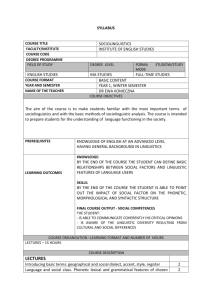
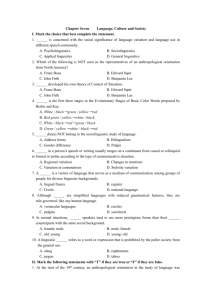
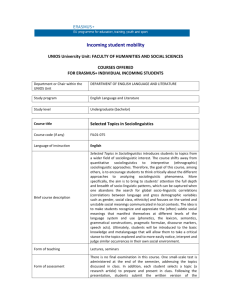

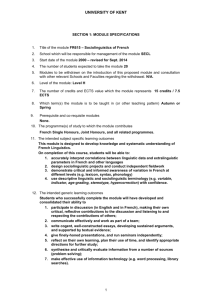

![Edward Sapir [1884-1939] - Frostburg State University](http://s2.studylib.net/store/data/005569801_1-deb1132f1ae8f0e8d561247b81673874-300x300.png)




